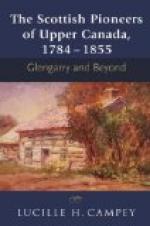His character has been so well summed up by Dr. S.E. Dawson, in his admirable book on the Story of the St. Lawrence Basin, that I cannot do better than quote his words:
“Champlain was as much at home in the brilliant court of France as in a wigwam on a Canadian lake, as patient and politic with a wild band of savages on Lake Huron as with a crowd of grasping traders in St. Malo or Dieppe. Always calm, always unselfish, always depending on God, in whom he believed and trusted, and thinking of France, which he loved, this single-hearted man resolutely followed the path of his duty under all circumstances; never looking for ease or asking for profit, loved by the wild people of the forest, respected by the courtiers of the king, and trusted by the close-fisted merchants of the maritime cities of France.”
CHAPTER V
After Champlain: from Montreal to the Mississippi
A very remarkable series of further explorations were carried out as the indirect result of Champlain’s work. In 1610 he had allowed a French boy of about eighteen years of age, named ETIENNE BRULE, to volunteer to go away with the Algonkins, in order to learn their language. Brule was taken in hand by Iroquet,[1] a chief of the “Little Algonkins”, whose people were then occupying the lands on either side of the Ottawa River, including the site of the now great city of Ottawa. After four years of roaming with the Indians, Brule was dispatched by Champlain with an escort of twelve Algonkins to the headwaters of the Suskuehanna, far to the south of Lake Ontario, in order to warn the Andastes[2] tribe of military operations to be undertaken by the allied French, Hurons, and Algonkins against the Iroquois. This enabled Brule to explore Lake Ontario and to descend the River Suskuehanna as far south as Chesapeake Bay, a truly extraordinary journey at the period. This region of northern Virginia had just been surveyed by the English, and was soon to be the site of the first English colony in North America.[3]
[Footnote 1: Mentioned on p. 80.]
[Footnote 2: The Andastes were akin to the Iroquois, but did not belong to their confederacy; they lived in Pennsylvania.]
[Footnote 3: The inaccurate statement has frequently been written about Newfoundland being “the first British American colony”. Newfoundland was reached by the ship in which John Cabot sailed on his 1497 voyage of discovery, and a few years afterwards its shores were sought by the English in common with the French and the Portuguese, and later on the Spaniards and Basques, for the cod fishery. But no definite British settlement, such as subsequently grew into an actual colony, was founded in Newfoundland until the year 1624; the island was not recognized as definitely British till 1713, and no governor was appointed till 1728. The first permanent English colonial settlement in America was founded at Jamestown, Virginia, in 1607; and in the Bermudas and Barbados (West Indies) soon afterwards.]




